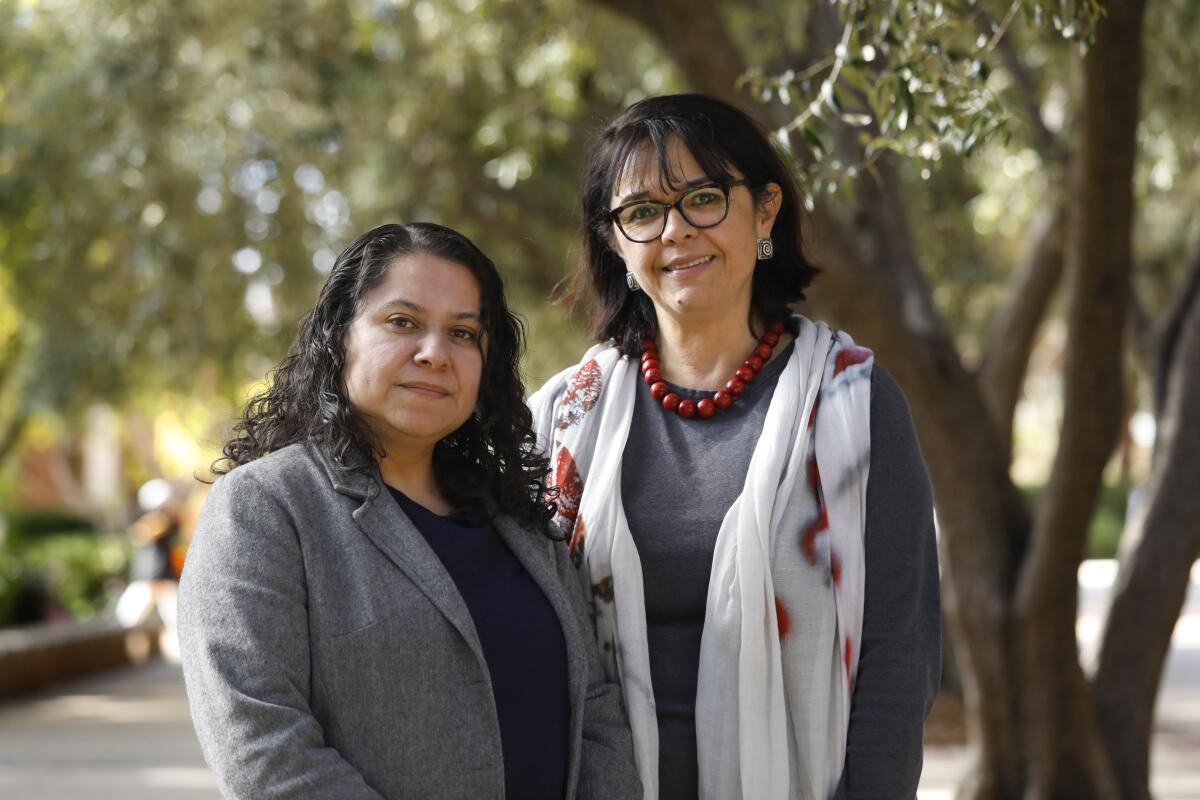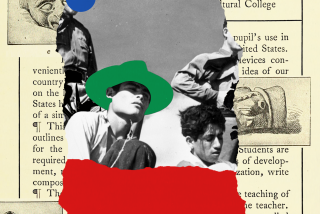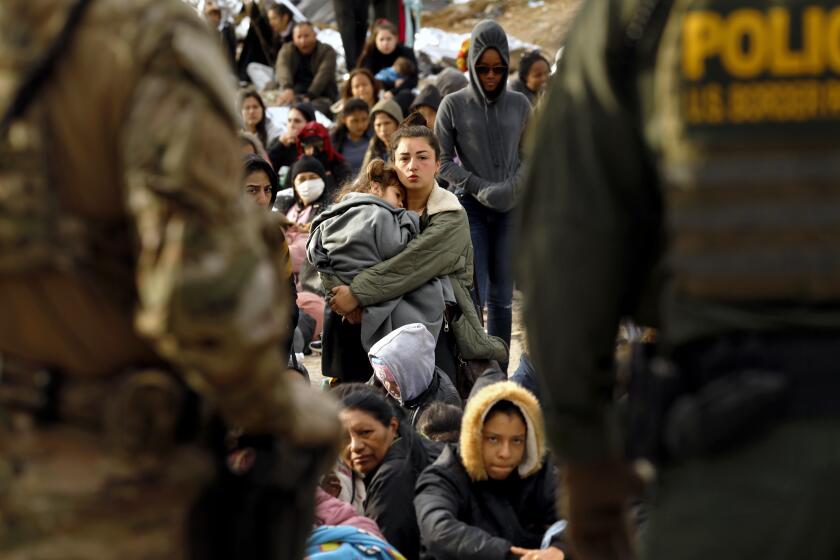Central Americans have long migrated north. Today, their studies are getting their due

It was a rare thing, a few decades ago, to hear anyone in academia talk about Central Americans.
“People would study Mexicans with no problem,” said Cecilia Menjívar, professor of sociology at UCLA. “But Central Americans were seen as a niche, a small group of people that didn’t seem as relevant.”
But on a recent afternoon, Menjívar, a native of El Salvador, stood inside a packed UCLA lecture hall introducing a notable lineup of professors invited to speak about Central American migration. They were social scientists from Los Angeles, Texas and different parts of Mexico including Chiapas, Tijuana and Mexico City.
“So many people showed up, we have two overflow rooms,” Menjívar said, sounding thrilled and a little surprised.
The central purpose of the conference was to show that Central Americans are not newcomers to the U.S. or to Mexico. They’ve been migrating north for at least a century, due to wars, poverty, violence and U.S. intervention.
Hondurans started arriving in the late 1800s in New Orleans, where bananas and other fruit from Central America entered the U.S. Salvadoran and Nicaraguan coffee producers began settling in small numbers in San Francisco in the early 1900s. And during and after World War II, U.S. wartime industries recruited scores of Central American workers.
Today, much of the contention over immigration centers on migrants from Central America. A record number of families have flocked to the U.S. border in recent years to seek refuge.
More than 430,000 family members from El Salvador, Guatemala and Honduras were caught at the U.S. border during the fiscal year that ended last September, according to U.S. Customs and Border Protection. Nationwide, more than 3 million Latinos have roots in these three Central American countries.
Recent immigrants have been met by both Democratic and Republican administrations with aggressively restrictive policies that have separated parents from their children, held them for extensive periods in detention centers and drove them back into Mexico and Guatemala to discourage them from applying for asylum.
Long before Central American migration dominated national headlines, some academics were pushing to study this region’s migrants, to get a deeper understanding of their history; the forces that drive them north and the complex relationship of their native countries to the U.S.
Menjívar began studying the topic as a grad student in the 1990s. By then, hundreds of thousands of Salvadorans had arrived in the U.S., seeking refuge in Los Angeles, Washington, D.C., and San Francisco. They escaped a brutal 12-year civil war that the U.S. government fomented and sponsored in the 1980s, spending billions of dollars to help support government oligarchs and right-wing death squads.
These migrants were received with hostility and suspicion in the U.S. Less than 2% were granted political asylum, giving way to a community without documentation and few to no rights.
Menjívar wanted to explore, from an academic standpoint, why the U.S. wasn’t receiving these migrants as war refugees. But finding any established research about Central Americans was difficult.
“I looked everywhere and could only find a couple of academics out there who were interested in this topic,” she said. “People didn’t understand what I was doing.”
Over the years, she and a small but committed number of scholars — several of them Central Americans — have worked diligently to create space for the field. They’ve published articles and books, created panels at academic conferences and began teaching courses at universities.
In 2000, after nearly a decade of intense lobbying, Cal State Northridge became the nation’s only university to establish a Central American Studies department with a Central American studies double major, major and minor. Back then, Cal State Northridge was home to 1,200 students of Central American descent, more than at any other American university.
At UCLA, Menjívar and a few other colleagues, some from El Salvador, Guatemala and Mexico, have partnered with Central American students to create a close-knit community of scholars passionate about studying the region and its diaspora.
In November, galvanized by the growing presence of Central Americans in Los Angeles and by national politics, many lobbied to have the César E. Chávez Department of Chicana & Chicano Studies add “Central American” to its name. Scholars hope to establish a Central American studies minor within the next year and a major within the next five.
At the gathering at UCLA, professors from the U.S. and Mexico took turns presenting work that many had been chipping away at for years — collecting data at migration centers, conducting interviews, surveys and studies — all to get the most accurate picture of the Central American migrant story. They delivered their lectures and responded to questions, in English and Spanish, inside of a lecture hall that stayed packed from 8 a.m. until past sundown.
The conference, planned about a year in advance, coincidentally took place the same week as a nationwide outcry erupted over another sort of migrant storytelling.
It had to do with “American Dirt,” a novel by Jeanine Cummins, that made headlines after the publishing industry and critics promoted it as the defining immigrant story of our times. When Latinos pushed back, calling the novel cartoonish, and riddled with inaccuracies and stereotypes, it sparked a weeks-long controversy over misrepresentation and cultural appropriation.
Scholars at UCLA didn’t bring up the book directly during the conference, but many were well aware of the uproar. In a world of research where precision and nuance is everything, they had their own concerns.
“It’s upsetting,” said Alfredo Trejo, 27, a PhD student of political science at UCLA. “We spend so much time and energy on our research. We have to make sure we get everything correct. Then, this book that distorts so much is hailed as the one book everyone should read to understand migration today.”
Late last year, Trejo, whose mom is Salvadoran, and other graduate students established the Central American Isthmus Graduate Assn. or CAIGA, a group that promotes Central American research on campus. They work side by side with the Central American Student Union, UNICA, an organization made up of undergrad Central American students.
Both groups are quite active at UCLA. Among other things, they want university research on Central Americans to be more accessible to the outside world.
“Academics usually make things sound a lot more complicated than they are,” Trejo said. “We want to make sure we’re working closely with the community at all times.”
Many of the students who enroll in Central Americans courses are often searching for themselves, trying to recover some part of their history. Their pasts are fragmented, obscured by a culture of silence and trauma. Also, by a U.S. school system that rarely, if ever, teaches Central American history.
Over the years, Rubén Hernández-León said he has seen Latino students explore their own communities with a great sense of rigor and commitment. Still, says the director of UCLA’s Center for Mexican Studies, he regularly has to push back against critics who think students of color are not equipped to research their own histories.
“It’s the so-called ‘me-research’ argument,” Hernández-León said. “Some think you’re too close to the subject to be objective. You don’t have the distance to do the cold, scientific research.”
Hernández-León partnered with Menjívar and Leisy Abrego, a professor in the Department of Chicana and Chicano and Central American Studies, to organize the recent conference on Central American migration.
One researcher, a longtime expert named Amarela Varela of the National Autonomous University of Mexico, spoke about the growing militarization of Mexico, as the country has partnered with the U.S. to push back Central American immigrants since the 1980s. According to the National Commission of Human Rights, she said, 8 out of 10 crimes against immigrants are are committed in collusion with Mexican state officials.
Rodolfo Casillas, a scholar from the Latin American Social Sciences Institute in Guatemala, spoke about the great anxiety Mexicans are feeling about Central American migration. The fear, he said, is largely overblown and race-based. As of 2015, Central Americans made up little more than half a percentage of Mexico’s population.
Floridalma Boj Lopez, an assistant professor at Cal State Los Angeles, talked about Guatemalan Mayans, a community she knows well from growing up Mayan in Los Angeles. Boj Lopez explored the indigenous group’s traumatic history of genocide, war and poverty. She said when Mayans cross into Mexico, they face a disproportionate level of racism and struggle to find anyone who understands their language.
“We’re talking about an entire structure that doesn’t recognize them and excludes them,” Boj Lopez said.
In recent years, scholars studying Central Americans have cultivated a close network across the country, with students eager to learn from each other and grow the field.
“It’s still new and it’s still growing. There’s mentorship happening on a national level,” said Abrego, who began teaching at UCLA a decade ago.
Abrego championed having her department add Central Americans to its title. She constantly promotes Central American research on social media and encourages everyone to share their work using #CentAmStudies.
Those who worked to establish the Central American department at Cal State Northridge recognize how much the field has grown.
“That department didn’t come from the benevolence of the Cal State system,” said Roberto Lovato, the program’s former coordinator. “It was an actual political struggle.”
Their battle, in some ways, was similar to what Chicanos and African American studies endured in the 1960s to establish their own departments at universities, including Cal State Northridge. What helped Salvadorans, he said, was their long history of organizing in times of warfare and political upheavals.
Today, Lovato said, he’s encouraged by the growing number of young Central American scholars committed to studying their communities.
“These are places where our culture is being preserved, developed and documented,” Lovato said. “And intellectually, these are scholars who will not be stopped in their pursuit of learning about themselves.”
More to Read
Start your day right
Sign up for Essential California for news, features and recommendations from the L.A. Times and beyond in your inbox six days a week.
You may occasionally receive promotional content from the Los Angeles Times.







